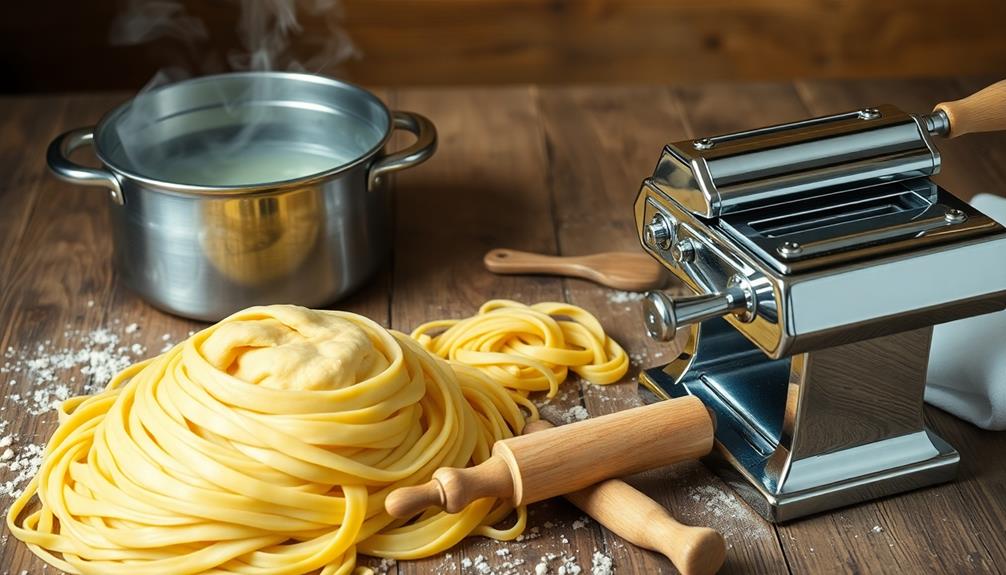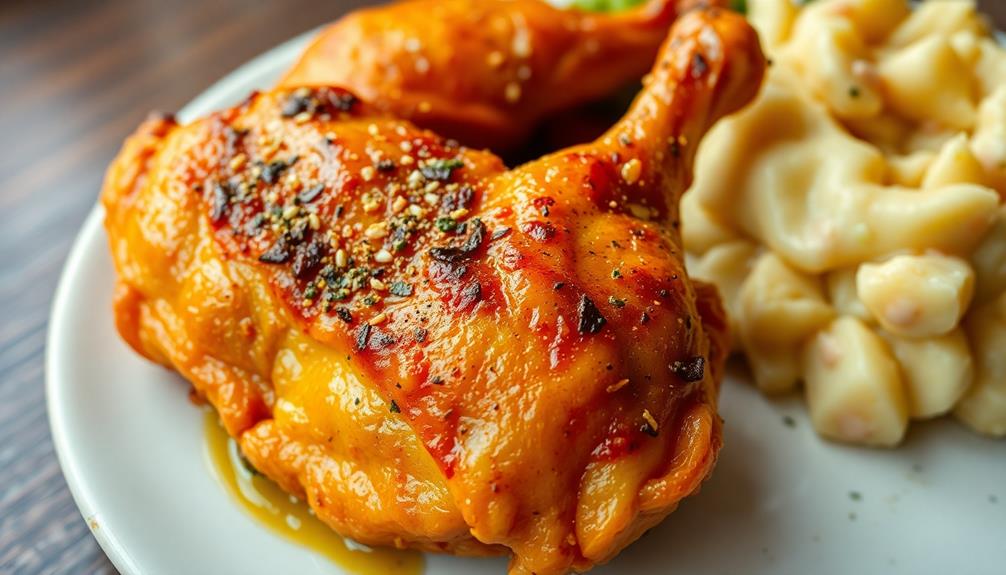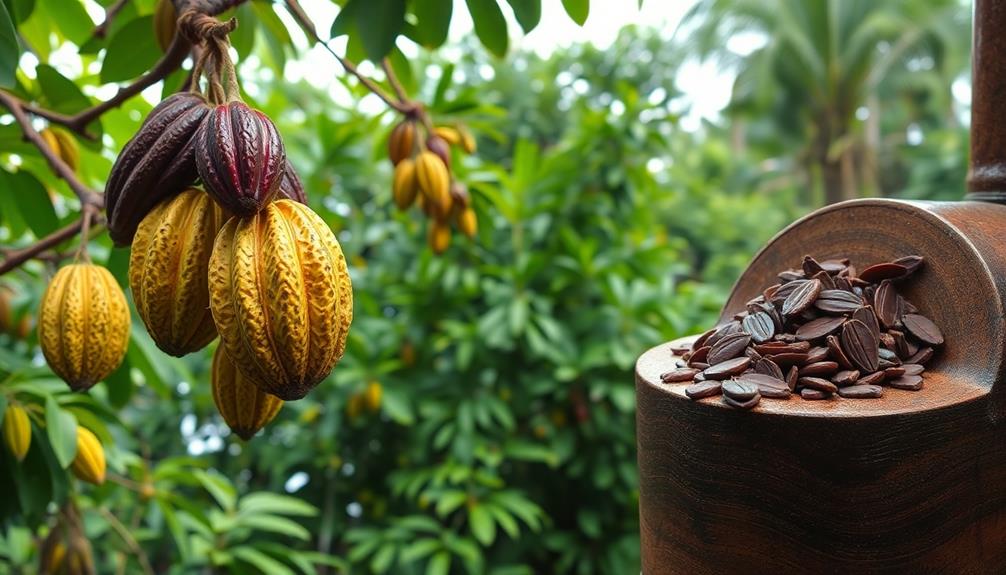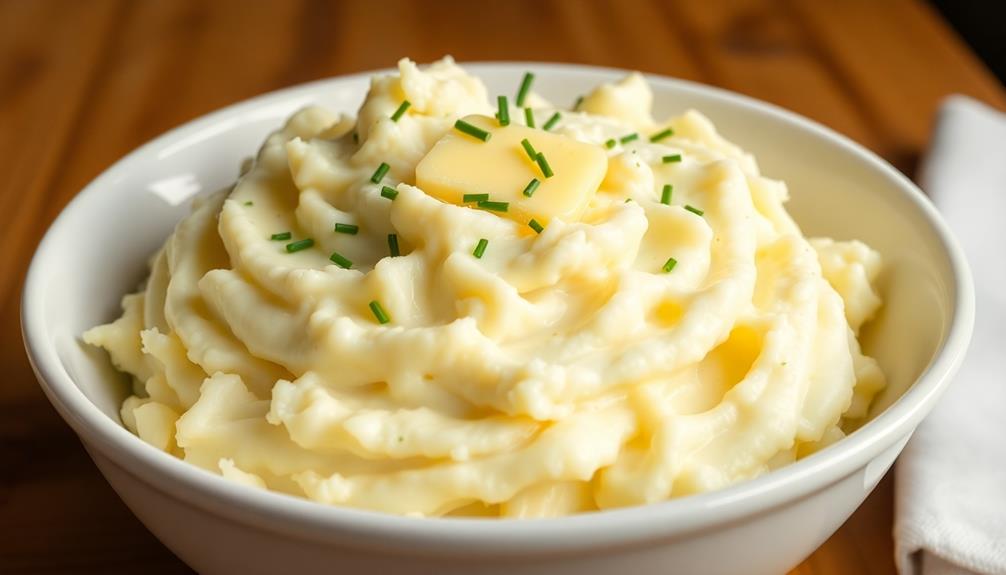Master the art of crafting perfect pasta every time with a few simple steps and high-quality ingredients. Originating centuries ago in ancient civilizations, pasta has evolved into a beloved global staple. For a restaurant-worthy dish, start by boiling salted water and gently adding dried pasta. Drain the pasta, reserving the starchy cooking water to toss with your desired sauce. Top with fresh herbs for vibrant flavor and visual appeal. The key lies in achieving that sought-after al dente texture and harmonious balance of seasonings. Follow these tips, and you'll be impressing your loved ones with homemade pasta perfection. Dive deeper to expand your culinary repertoire. Experimenting with different sauces and ingredients can turn a simple meal into a culinary adventure. If you’re new to cooking, start with an easy spaghetti recipe for beginners, combining the starchy cooking water with a classic marinara or garlic and olive oil for a foolproof dish. With practice and creativity, you’ll soon be customizing pasta dishes that cater perfectly to your taste buds and bring joy to the table.
Key Takeaways
- Use high-quality dried pasta to enhance the overall flavor and texture of the dish.
- Properly salt the cooking water to infuse the pasta with flavor.
- Reserve some of the starchy pasta water to help emulsify the sauce.
- Cook the pasta to an al dente texture for the perfect bite.
- Garnish with fresh herbs and a drizzle of olive oil to elevate the dish's aroma and visual appeal.
History
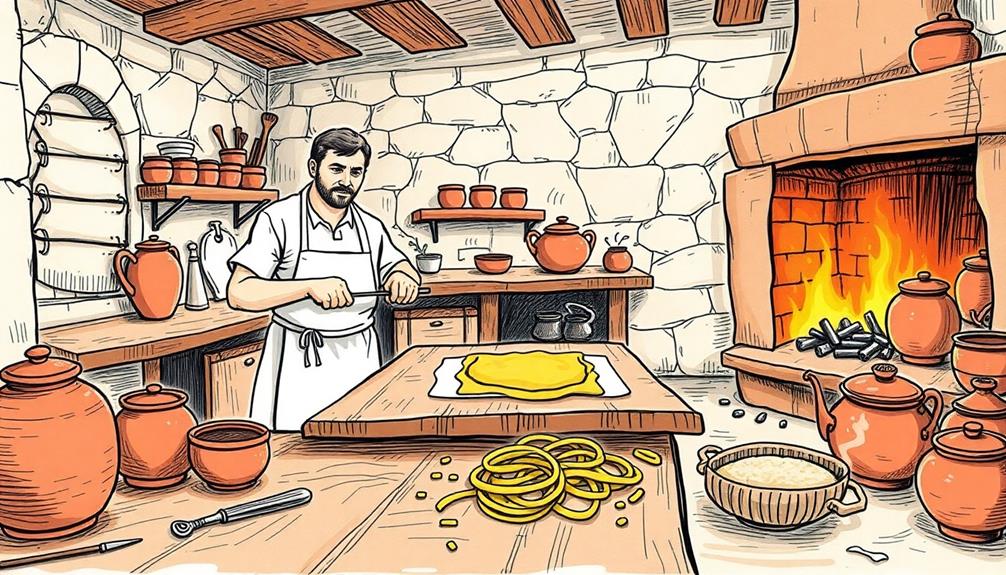
When did pasta first emerge as a culinary staple? It's believed that the origins of pasta can be traced back to ancient civilizations in China and the Middle East, where people were making noodle-like foods as early as 2000 BC.
However, the pasta we know and love today has its roots in Italy. The earliest records of pasta production in Italy date back to the 13th century, when it was a popular food among the wealthy.
Over time, pasta became more widely available and accessible to the masses. Advancements in milling technology and the introduction of dried pasta allowed for mass production and longer shelf life, making pasta a dietary staple for Italians and eventually, the world.
Today, pasta is a beloved dish enjoyed by people of all backgrounds, with countless variations and regional specialties. From classic spaghetti to innovative fusilli, the versatility of pasta makes it a timeless and essential part of many cultures' cuisines.
Recipe
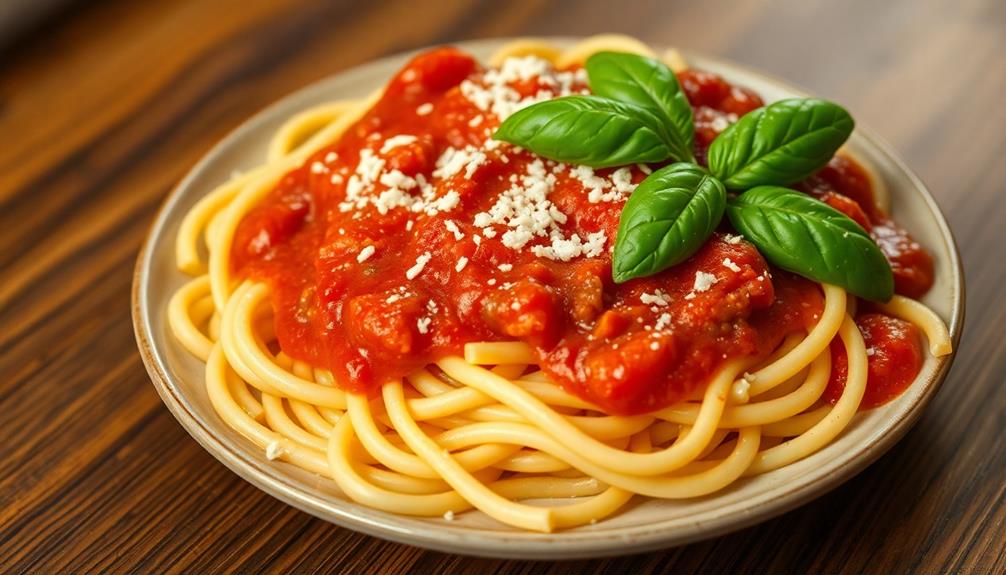
Pasta is a beloved staple in many households, and crafting the perfect bowl can be a true culinary delight. This recipe for a delectable pasta dish promises to transport your taste buds to the heart of Italy, with its harmonious blend of flavors and textures.
At the core of this recipe lies the importance of using high-quality ingredients. Selecting the right pasta, choosing the freshest produce, and incorporating the perfect balance of seasonings are all crucial elements that contribute to the overall success of this dish.
Ingredients:
- 1 lb. dried pasta (such as spaghetti, linguine, or penne)
- 4 cloves of garlic, minced
- 1 onion, diced
- 2 cups of cherry tomatoes, halved
- 1/2 cup of fresh basil leaves, chopped
- 1/4 cup of grated Parmesan cheese
- 2 tablespoons of olive oil
- Salt and freshly ground black pepper, to taste
To prepare this mouthwatering pasta dish, begin by bringing a large pot of salted water to a boil. Add the pasta and cook according to the package instructions until al dente. Drain the pasta, reserving a cup of the starchy cooking water.
In a large skillet, heat the olive oil over medium heat. Add the minced garlic and diced onion, and sauté until fragrant and the onions are translucent. Toss in the halved cherry tomatoes and continue to cook until they begin to burst and release their juices.
Gently fold in the cooked pasta, along with a splash of the reserved cooking water, to create a luscious, sauce-like consistency. Season the dish with salt and freshly ground black pepper to taste, and finish with a generous sprinkle of fresh basil leaves and grated Parmesan cheese.
For the perfect pasta experience, be mindful of the cooking time to achieve the desired al dente texture, and don't be afraid to experiment with different types of pasta to find your personal preference.
Enjoy this delightful dish with family and friends, and let the flavors of Italy transport you to a culinary oasis.
Cooking Steps
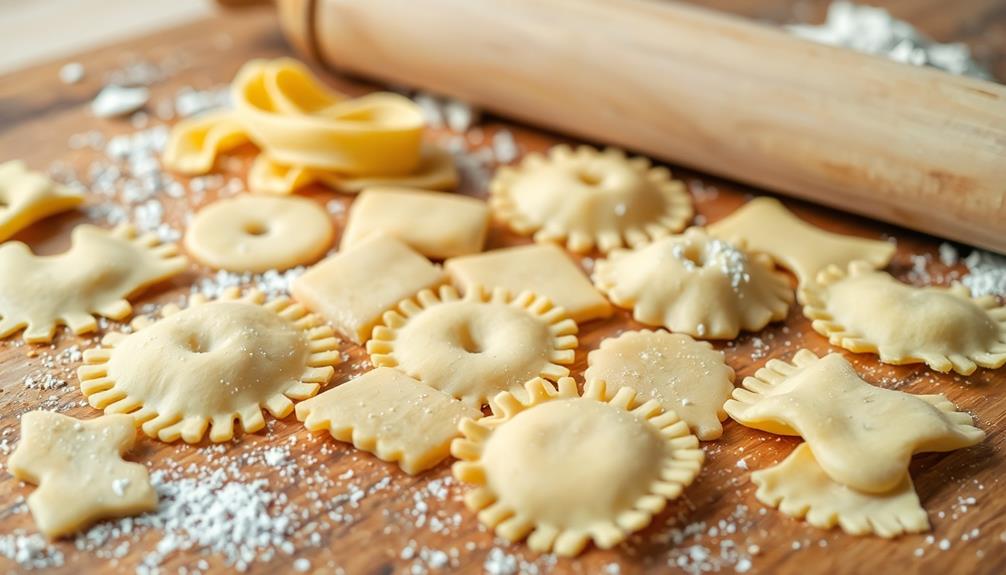
Boil the water vigorously and salt it generously.
Once the water is at a rolling boil, add the pasta and cook until it's al dente.
Drain the pasta, reserving some of the cooking water, then toss it with your desired sauce and garnish with fresh herbs.
Step 1. Boil Salted Water Vigorously
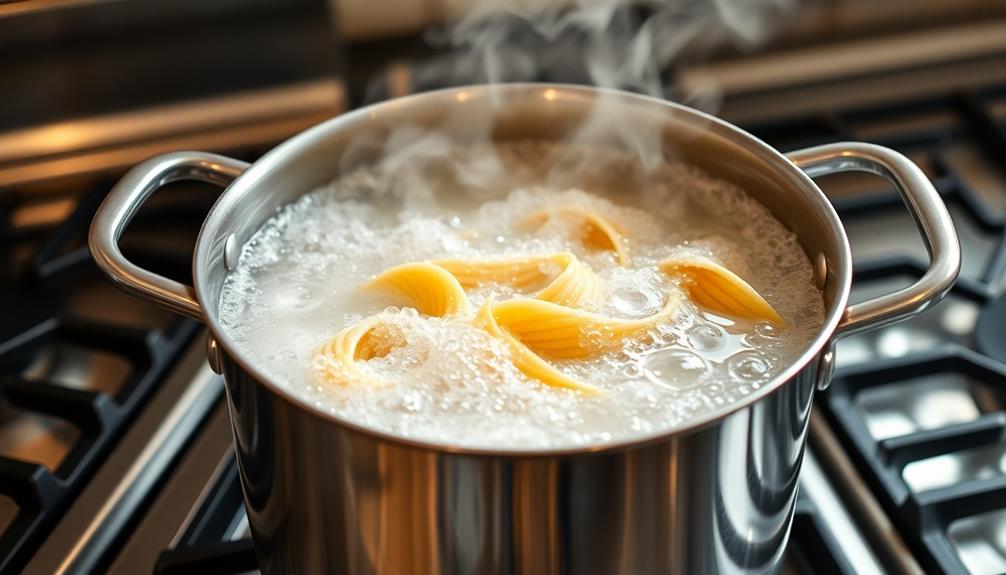
To start, you'll want to bring a large pot of water to a vigorous boil. The key here is to use a sizable pot – at least 4 quarts – to ensure you have enough room for the pasta to move around freely as it cooks.
Add a generous amount of salt to the water, around 1-2 tablespoons. This helps season the pasta from the inside out, imparting delicious flavor.
Once the water is at a rolling boil, you can go ahead and add your dry pasta. Give it a gentle stir to prevent the noodles from sticking together.
Allow the water to return to a vigorous boil, then set a timer according to the package instructions. Generally, dried pasta will need 8-12 minutes to reach the perfect al dente texture.
Be sure to taste test a strand or two as it nears the recommended cook time, as cooking times can vary.
Drain the pasta thoroughly, reserving a cup of the starchy cooking water, and you're ready to toss it with your desired sauce.
Step 2. Add Pasta
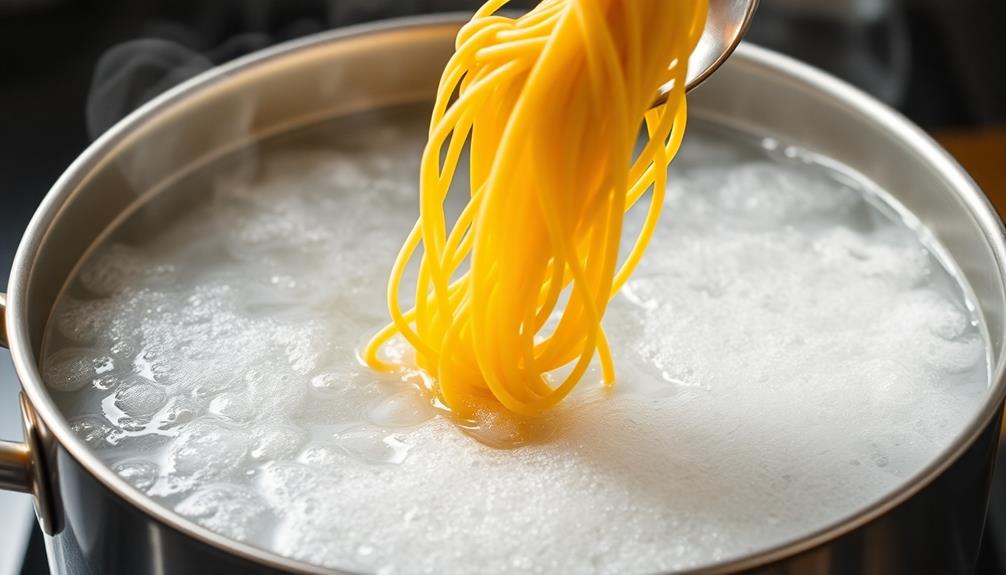
Once the water is at a vigorous boil, you can go ahead and add your dry pasta. Be sure to gently drop the noodles into the boiling water, rather than dumping them in all at once. This helps prevent the pasta from sticking together.
It's important to stir the pasta immediately after adding it to the pot, continuing to stir occasionally throughout the cooking process. This ensures even cooking and prevents clumping.
The amount of pasta you add will depend on how many servings you're preparing. As a general guideline, plan for 2-3 ounces of dry pasta per person.
Once the pasta is in the water, set a timer according to the package instructions. Most dried pasta varieties will be done in 8-12 minutes.
To test for doneness, you can use a fork to fish out a piece and give it a taste. The pasta should be tender but still have a slight bite, known as "al dente."
Step 3. Drain Pasta, Reserving Cooking Water
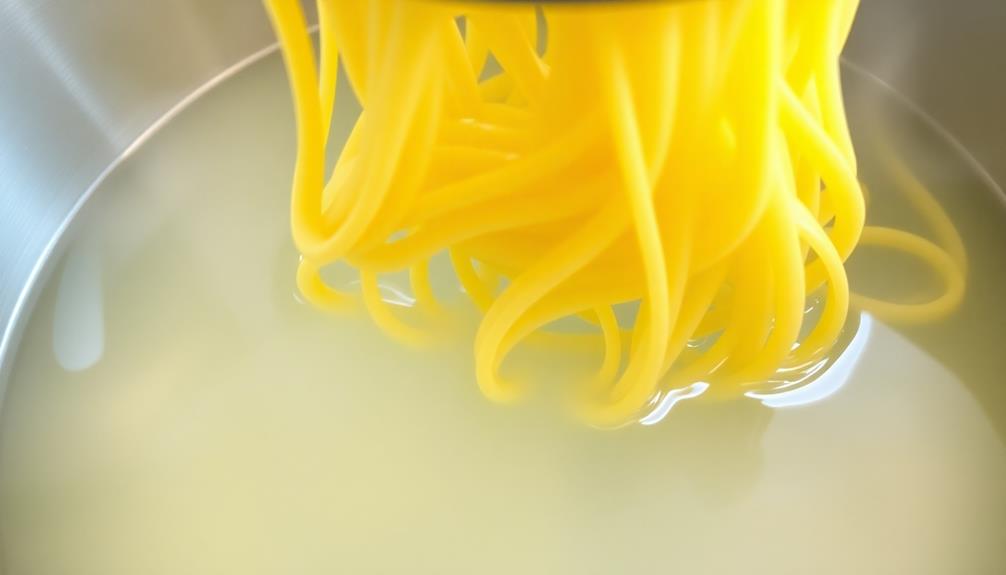
When the pasta has finished cooking, go ahead and drain it using a colander.
Be sure to reserve about a cup of the starchy pasta cooking water – this liquid gold will come in handy for saucing your pasta later on.
Carefully pour the pasta into the colander, letting the hot water drain away.
Don't rinse the pasta under cold water, as this will wash away that precious starch.
Instead, let the pasta sit in the colander for a minute or two to fully drain.
The reserved cooking water serves a few important purposes:
- It helps the sauce cling to the pasta noodles for optimal flavor.
- It can be used to thin out sauces that have thickened too much.
- The starch in the water acts as a binder, helping the sauce emulsify for a silky, velvety texture.
Step 4. Toss With Desired Sauce
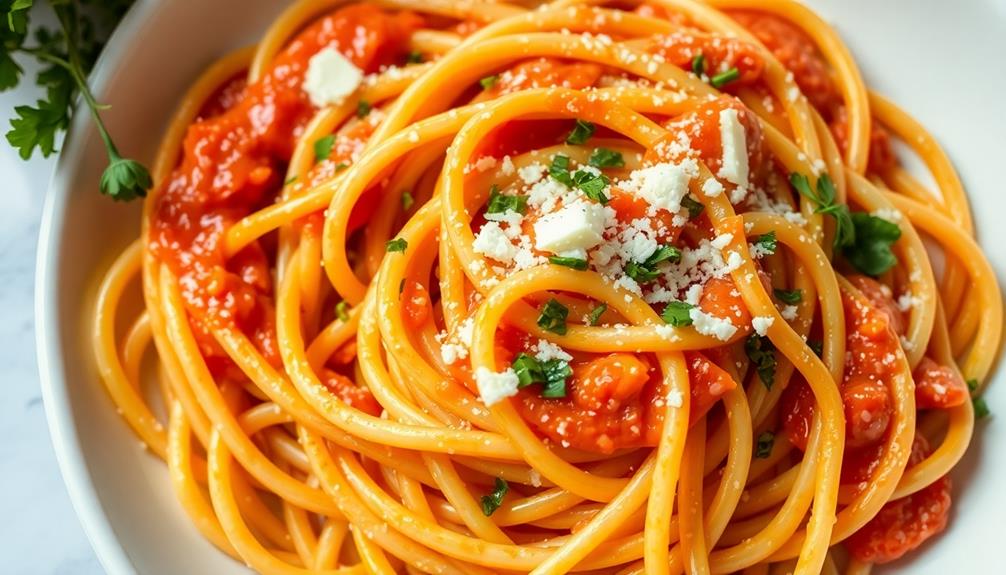
Now that you've drained the pasta and reserved that precious cooking water, it's time to toss it with your desired sauce. This is a crucial step in achieving the perfect pasta dish, as the sauce is what brings all the flavors together.
Begin by choosing your sauce – whether it's a classic tomato-based marinara, a creamy Alfredo, or a light and fragrant pesto, the possibilities are endless.
Once you've selected your sauce, slowly add it to the drained pasta, using the reserved cooking water to help the sauce cling to the noodles. Toss the pasta and sauce together gently, adding small amounts of the cooking water as needed to achieve your desired consistency.
The starch in the cooking water will help emulsify the sauce, creating a silky, glossy coating on the pasta. Continue tossing until the sauce is evenly distributed and the pasta is hot throughout.
Now, you're ready to serve your perfectly sauced and seasoned pasta creation.
Step 5. Garnish With Fresh Herbs
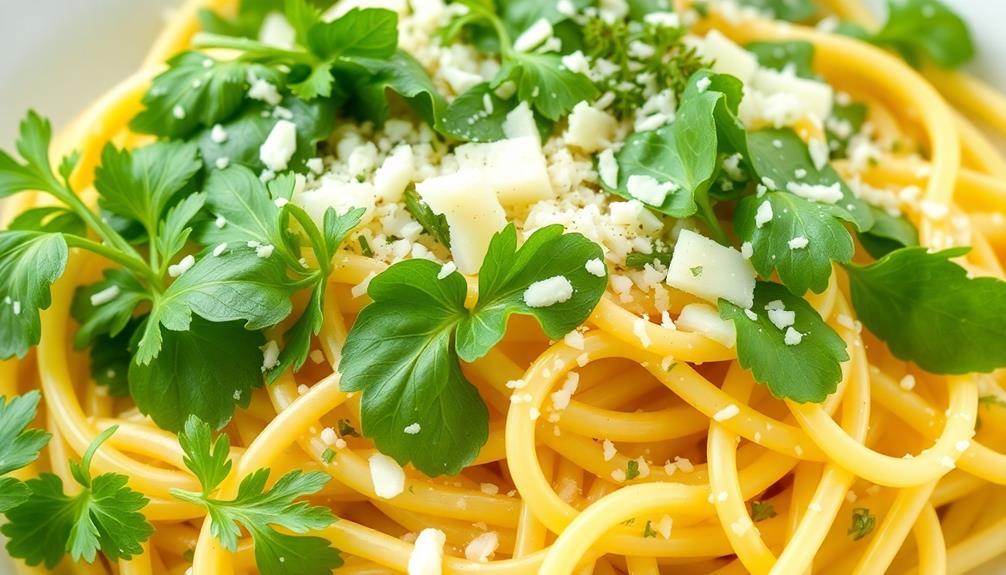
Finally, garnish your perfectly sauced pasta with fresh, fragrant herbs. This simple step can elevate your dish, adding a burst of flavor and visual appeal. Chopped parsley, basil, oregano, or a combination thereof, work wonderfully.
Sprinkle the herbs generously over the top of the pasta, ensuring they're evenly distributed. Fresh herbs not only enhance the flavor but also offer various health benefits, similar to those found in herbal teas, making your meal both delicious and nutritious.
The key is to use herbs that are as fresh as possible. If using dried herbs, consider reducing the amount, as their flavor is more concentrated. For maximum impact, add the herbs just before serving, as this will preserve their vibrant color and aroma.
- Chop the herbs finely, using a sharp knife or kitchen shears.
- Gently toss the herbs into the pasta, being careful not to overmix and bruise them.
- Adjust the amount of herbs to suit your personal taste preferences.
- Consider garnishing with a drizzle of high-quality olive oil or a dusting of Parmesan cheese for extra flavor.
Enjoy your perfectly garnished pasta dish!
Final Thoughts
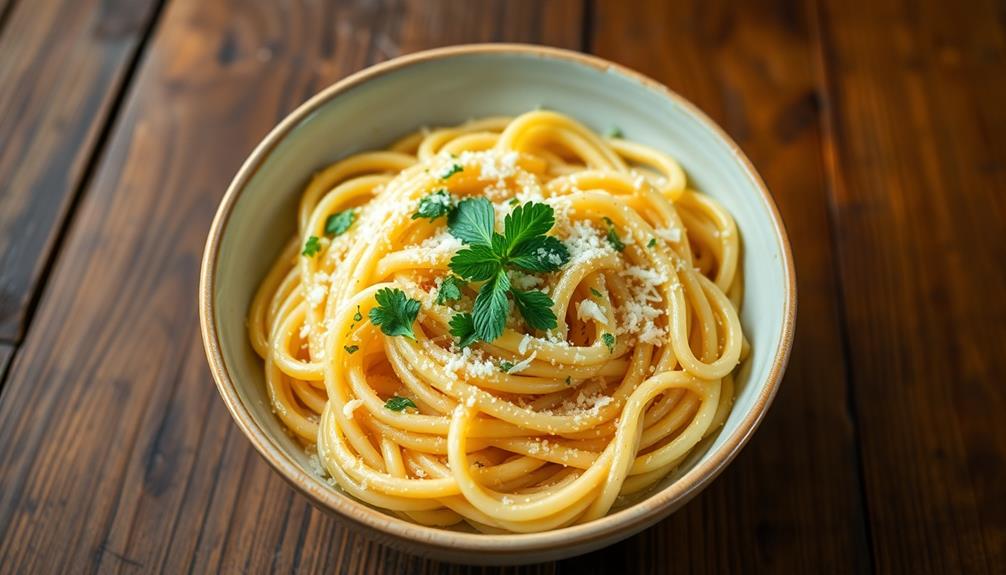
With the perfect pasta recipe now at your fingertips, you can confidently elevate your culinary skills and impress your loved ones. Creating a delicious, restaurant-quality pasta dish has never been easier. Whether you’re a seasoned chef or just starting in the kitchen, this perfect pasta recipe for beginners ensures that anyone can achieve mouthwatering results. The simple steps and easily accessible ingredients make it both foolproof and enjoyable. Say goodbye to takeout and start serving up homemade, flavorful pasta that rivals any dish at your favorite restaurant!
From the perfectly al dente texture to the vibrant flavors, this recipe is sure to become a staple in your kitchen.
As you've discovered, the key to achieving pasta perfection lies in the details – from properly salting the cooking water to gently tossing the pasta with the sauce.
Frequently Asked Questions
Can I Use Fresh or Dried Pasta for This Recipe?
You can use either fresh or dried pasta for this recipe. Fresh pasta will result in a more delicate texture, while dried pasta is more durable and holds up well in sauces. Choose whichever type suits your preferences and cooking needs.
How Can I Avoid Overcooking the Pasta?
To avoid overcooking the pasta, be sure to set a timer and check it frequently. Taste the pasta throughout the cooking process to ensure it reaches your desired doneness. Don't be afraid to adjust the cooking time as needed.
Is It Necessary to Add Salt to the Pasta Water?
Adding salt to the pasta water isn't strictly necessary, but it can enhance the flavor of your pasta. The salt helps season the pasta from the inside out, so it's worth considering if you want to maximize the taste.
Can I Use a Different Type of Cheese in the Recipe?
You can absolutely use a different type of cheese in the recipe. The cheese you choose should complement the other flavors in the dish. Feel free to experiment with various cheeses to find your favorite combination.
How Long Will the Cooked Pasta Keep in the Refrigerator?
Cooked pasta can typically keep in the refrigerator for 3-5 days. Store it in an airtight container, and it'll stay fresh and ready to use in your favorite dishes. Just reheat it gently when you're ready to enjoy it again.
